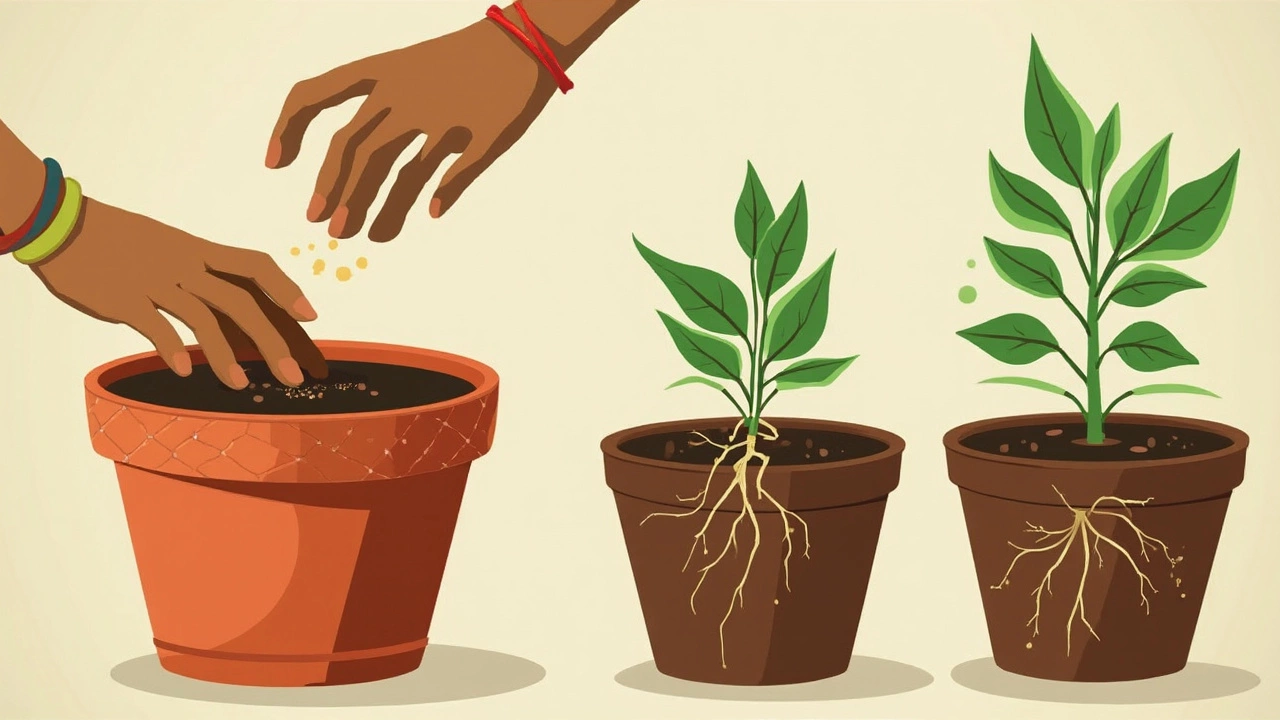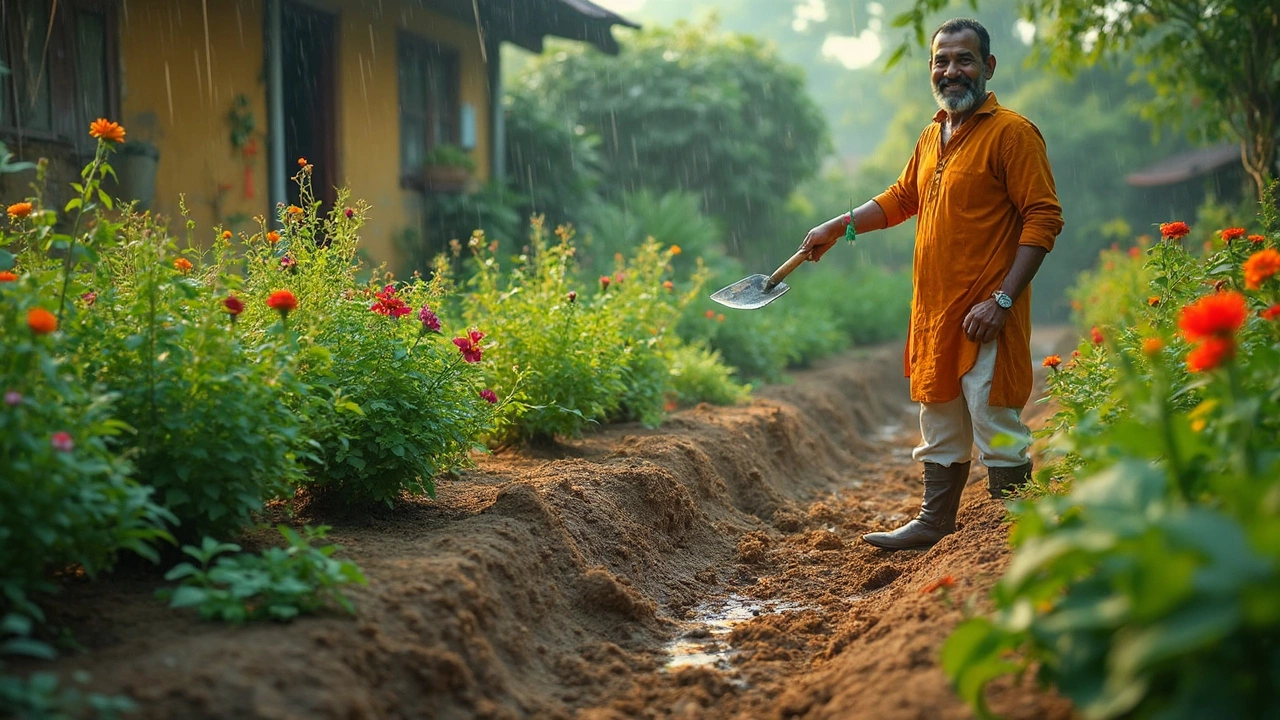Ever sunk your boot into a soggy spot in your yard, only to pull up mud that could probably swallow your shoe whole? Yeah, been there. Waterlogged dirt doesn't just look bad—it chokes your plants and wrecks any chance at strong growth. Figuring out how to make soil drain faster isn't just for pros; it's something anyone with a shovel can tackle.
The quick reality: not every soil problem needs an expensive fix. Sometimes, just adding the right stuff—like sand or compost—turns dense, stubborn soil into a place roots can actually breathe. Other times, a bit of smart digging or raising your beds does the trick faster than you’d think. It's less about fancy gear and more about understanding what your garden really needs.
- What Bad Drainage Actually Looks Like
- Quick Fixes That Work Right Away
- Long-Term Solutions for Happy Roots
- Common Pitfalls and Drainage Myths
What Bad Drainage Actually Looks Like
Think your soil might have poor drainage? The clues are usually pretty obvious once you know what to look for. You’ll notice puddles hanging around for hours—or even days—after rain, especially in low spots. If you stick your finger or a small spade into the ground, the dirt will often feel sticky and heavy. Sometimes, it can even smell a bit sour, since oxygen struggles to reach the roots under waterlogged conditions.
Plants will start showing signs, too. Look out for yellowing leaves, wilting (even though the soil is wet), and stunted growth. These are all classic signs that roots are basically drowning, not getting enough air, and maybe even starting to rot. Lawns growing in tight, dense soil often look patchy and mossy instead of green and healthy.
Another simple test: dig a hole about a foot deep, fill it with water, and see how fast it drains. If the water is still sitting there a few hours later, you’ve got a soil drainage problem for sure.
- Persistent surface puddles after rain
- Soil feels dense, sticky, or clumpy
- Unhealthy, yellow, or droopy plants despite wet soil
- Bad, swampy smells near plant roots
- Poor lawn growth with lots of moss or bare spots
Spotting these signs early means you can step in before roots start rotting. Nobody wants to dig up dead shrubs or deal with plants that never seem to thrive. If you’re seeing more than one sign from the list above, you’re definitely in the right place to start fixing it.
Quick Fixes That Work Right Away
If puddles stick around for hours or your plants look like they’re gasping for air, it’s time for an upgrade. Tackling drainage doesn’t mean you need to rip up the whole yard. Here’s what you can do—starting today—to get water moving out of those soggy spots.
- Soil drainage improves instantly with organic matter. Grab some compost or bagged manure and spread a two-inch layer over your soil. Work it in about 6-8 inches deep. That stuff adds gaps for water to pass through and feeds your plants at the same time.
- Mix in coarse sand or perlite. But don’t use fine sand—that’ll turn your soil into cement when mixed with clay. Coarse builder’s sand makes a difference. Blend about one part sand to two parts soil where you see the worst puddling.
- Dig temporary trenches. Even a shallow, 4-inch trench can steer standing water away from problem spots. Direct it to a lower patch of your yard or out toward the street.
- Try quick aeration. Stab your patchy area with a garden fork every few inches to punch holes down 8 to 10 inches. That gives water somewhere to go fast, especially in heavy clay areas or where traffic packs soil down.
- If you’ve got raised beds, topping them off with a mix of topsoil and compost lets rain breeze right through instead of pooling up. Milo and I once fixed a stubborn veggie patch this way—and the carrots grew like crazy afterward.
Quick reference: How these fixes stack up for speed and impact—
| Fix | Time to Apply | Impact |
|---|---|---|
| Add Compost | 1-2 hours | Very Effective |
| Mix in Coarse Sand | 1-2 hours | Effective |
| Dig Trenches | 30 min-1 hour | Works Fast, May Be Temporary |
| Quick Aeration | 15-30 min | Helps Instantly, Lasts a Few Weeks |
| Raise Beds | 2-4 hours | Reliable & Long-lasting |
These steps don’t require much skill or special tools. Just a shovel, some simple supplies, and a free afternoon can make a world of difference for waterlogged patches.

Long-Term Solutions for Happy Roots
If your yard floods every spring or you’ve got stubborn clay that kills tomatoes before June, short fixes only get you so far. Tackling poor drainage for good means reshaping what’s under your feet. Here’s where lasting change really happens.
Soil drainage problems usually come from the way the soil particles pack together. When it’s mostly clay, water just sits on top or soaks in slowly, making roots rot and grass feel squishy. For a permanent fix, try these proven strategies:
- Mix in organic matter every year. Compost, chopped leaves, or even well-rotted manure help break apart heavy soil and boost airy spaces. Aim for at least 2-3 inches mixed into the top six inches of soil.
- Create raised beds. Even six-inch-tall wooden or stone frames filled with loose garden mix can make a huge difference. Raised beds warm up faster in spring and drain easily, especially in rainy climates.
- Install perforated drain pipes (French drains). For areas that stay soggy, dig trenches and bury a simple perforated pipe surrounded by gravel. This lets water escape without turning your yard into a swamp. Line the trench with landscape fabric to keep soil from clogging the pipe.
- Go with plants that thrive in soggier soil. Sometimes it’s easier to work with nature. Switch to moisture-loving varieties like iris, red twig dogwood, or swamp milkweed in your wettest spots.
Check out how these soil tweaks compare for actual improvement in drainage over a season:
| Treatment | Drain Time for 1" Rainfall | Plant Survival Rate |
|---|---|---|
| Unamended Clay Soil | 48+ hours | ~50% |
| Clay + Annual Compost | 12-18 hours | ~85% |
| Raised Beds | Under 8 hours | 95%+ |
| French Drain Addition | Under 6 hours | 98%+ |
For my own backyard, adding organic matter every fall finally turned that back corner from a moss pit into a place where Milo and I could actually grow beans. If you stick with these changes for a couple of seasons, you’ll see fewer puddles and happier plants—no guesswork needed.
Common Pitfalls and Drainage Myths
It’s wild how much garden advice gets passed around that just doesn’t help—or actually makes things worse. When it comes to soil drainage, a few old-school fixes keep showing up in conversations and on YouTube, but a lot of them have been busted by researchers and pro gardeners.
- Myth: Putting gravel or rocks in the bottom of planting holes or pots helps drainage. This one’s a classic, but in reality, the water tends to sit on top of the gravel layer, not pass through it faster. Soil scientists have proven that this makes the drainage problem worse by creating a perched water table, leaving roots right in a wet spot.
- Pitfall: Adding only sand to clay soils. Dump a bunch of sand into clay, and you might end up with something closer to concrete than a garden bed. Without plenty of organic matter mixed in, heavy soils just get stickier and harder.
- Myth: All soils need the same fix. Nope! What works in one yard—or even one garden bed—can fail a few feet away. Drainage depends on the soil type, how compacted it is, the plants you’ve got, even the slope. Always check your specific spot first.
- Pitfall: Skipping regular checks after a "fix." You might haul in new compost or make a raised bed, but if you don’t see how water drains afterward, you’re flying blind. Run a hose for a few minutes and watch—not just on the surface, but after digging a hole and checking how fast it drains.
Here’s a quick table showing what actually happens with common tricks versus what gardeners think happens:
| Trick or Myth | What People Think | What Really Happens |
|---|---|---|
| Gravel Layer | Improves drainage | Slows water movement, traps moisture above |
| Sand in Clay | Breaks up clay, boosts flow | Makes soil denser unless mixed with compost |
| Organic Matter | Might make things soggier | Actually helps water move and roots breathe |
| Drainage Holes (Pots) | Always enough for fast draining | Clogs fast if soil compacts, needs regular checks |
So, next time you hear a friend swear by “just tossing in some gravel,” remember—sometimes the classic advice is just plain outdated. For real results, focus on adding organic matter, digging test holes, and actually watching what your soil does after rain. Your plants (and your boots) will thank you.

